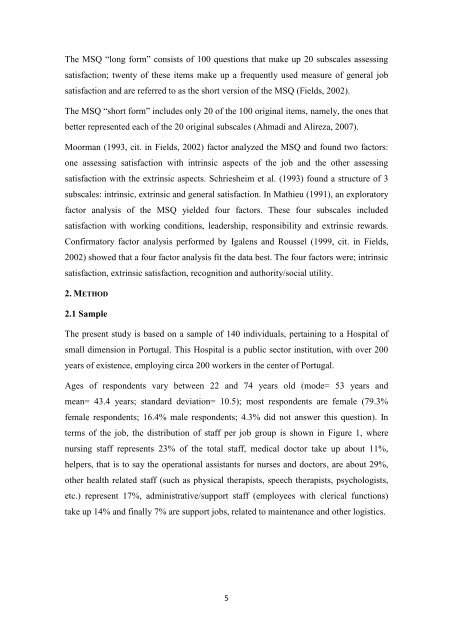Minnesota Satisfaction Questionnaire - FEP - Working Papers
Minnesota Satisfaction Questionnaire - FEP - Working Papers
Minnesota Satisfaction Questionnaire - FEP - Working Papers
You also want an ePaper? Increase the reach of your titles
YUMPU automatically turns print PDFs into web optimized ePapers that Google loves.
The MSQ “long form” consists of 100 questions that make up 20 subscales assessingsatisfaction; twenty of these items make up a frequently used measure of general jobsatisfaction and are referred to as the short version of the MSQ (Fields, 2002).The MSQ “short form” includes only 20 of the 100 original items, namely, the ones thatbetter represented each of the 20 original subscales (Ahmadi and Alireza, 2007).Moorman (1993, cit. in Fields, 2002) factor analyzed the MSQ and found two factors:one assessing satisfaction with intrinsic aspects of the job and the other assessingsatisfaction with the extrinsic aspects. Schriesheim et al. (1993) found a structure of 3subscales: intrinsic, extrinsic and general satisfaction. In Mathieu (1991), an exploratoryfactor analysis of the MSQ yielded four factors. These four subscales includedsatisfaction with working conditions, leadership, responsibility and extrinsic rewards.Confirmatory factor analysis performed by Igalens and Roussel (1999, cit. in Fields,2002) showed that a four factor analysis fit the data best. The four factors were; intrinsicsatisfaction, extrinsic satisfaction, recognition and authority/social utility.2. METHOD2.1 SampleThe present study is based on a sample of 140 individuals, pertaining to a Hospital ofsmall dimension in Portugal. This Hospital is a public sector institution, with over 200years of existence, employing circa 200 workers in the center of Portugal.Ages of respondents vary between 22 and 74 years old (mode= 53 years andmean= 43.4 years; standard deviation= 10.5); most respondents are female (79.3%female respondents; 16.4% male respondents; 4.3% did not answer this question). Interms of the job, the distribution of staff per job group is shown in Figure 1, wherenursing staff represents 23% of the total staff, medical doctor take up about 11%,helpers, that is to say the operational assistants for nurses and doctors, are about 29%,other health related staff (such as physical therapists, speech therapists, psychologists,etc.) represent 17%, administrative/support staff (employees with clerical functions)take up 14% and finally 7% are support jobs, related to maintenance and other logistics.5











